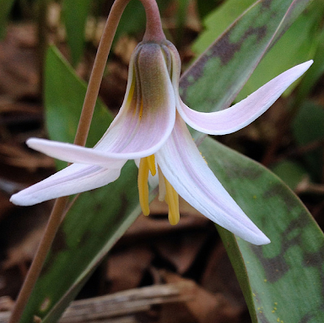Asian Jumping Worms: A New Wave of Worm Invaders Threatening Temperate Forests
- Mary Gumerov
- Dec 23, 2021
- 3 min read
Before European colonization, there were no earthworms in regions north of New Jersey stretching to Washington state.
The Ice Age wiped out native Earthworm populations 15,000 years ago as glaciers covered parts of the North American landscape. As a result, temperate forests, including forests in Maryland, evolved to thrive without worms by relying on thick layers of slowly decomposing leaves, known as duff, that enrich and protect the soil while providing food and shelter for wildlife and native woodland plants.

But, with the introduction of European Earthworms in the 17th century, biodiversity in temperate forests took a hit. Earthworms are like tillers that mix and consume soil and organic material. As a result, our forests have less leaf litter, fewer native woodland plants such as trillium, trout lily and spring beauty bloom, and release more carbon into the atmosphere from the Earthworm’s constant churning of carbon in the soil.
Pictured below from left to right: Spring Beauty Bloom (Claytonia virginica), White Trout Lily (Erythronium albidum), Trillium (Trillium grandiflorum)
However, Common Earthworms (Lumbricus terrestris) have redeemed themselves in agriculture and gardening by enhancing soil quality in areas lacking trees.
Earthworms soften compacted soils by tunneling through the ground, allowing water and oxygen to penetrate deeper into the soil while providing space for plant roots to flourish. As they ingest soil and organic matter, earthworms concentrate essential nutrients through their waste, known as worm castings, which revitalizes spent soils without the use of chemicals.
Though we have adapted to European earthworms in our forests and agricultural lands over the last 400 years, we now face a new ecological challenge: Asian Jumping Worms.
In the past 15 years, Jumping Worms struck Southern and Mid-Atlantic soils and continue to spread to other regions of the United States. What differentiates Jumping Worms from their European counterparts is that they do not tunnel, they grow and multiply rapidly, and they have a voracious appetite.

As they snake through the ground's surface, Jumping Worms devour the protective layer of leaves on forest floors, leaving behind dry, compacted castings that look and feel like coffee grounds. These nutrient-dense castings wash away into streams, creating additional damage to waterways from nutrient pollution. By altering native soil chemistry and structure, Jumping Worms displace native vegetation by creating favorable conditions for invasive plants to thrive.
Yet, the harms mentioned wouldn’t be as catastrophic if Jumping Worms didn’t grow and reproduce so quickly: their uncanny ability to grow seven times as fast as Common Earthworms and reproduce parthenogenetically (without a mate) which enables them to infest forests in high densities which intensifies their destructiveness.


Before and after of a forest infested with Jumping Worms. Photo by Scott Loss.
How did Asian Jumping Worms get here in the first place?
They first arrived in California in the 1860s from imported plants from East Asia. Since then, Americans have spotted them in other parts of the country, particularly in the South where they are called Alabama Jumpers. Although Jumping Worms were in the United States for over a century, their population skyrocketed only in the past decade.
They likely proliferated from compost enterprises that use Jumping Worms to speed up the nutritional breakdown of organic matter and from companies that sell them as fish bait. Another reason why they've spread is from increased movement of materials.

When adult populations die after the first frost, the worms leave behind cocoons the size of mustard seeds that blend in with the ground. These cocoons are resistant to the cold and cling onto shoes and landscaping tools, traveling far until the eggs inside the cocoons eventually hatch in late Spring.
Jumping Worms cocoons. Cocoons may contain up to two eggs.
There are no proven treatments for eradicating established worm populations, but research shows promise in heat treatments, biochar, saponins (a plant extract in soap), and certain fungi. As we experiment with treatment options, the best we can do is limit their spread.

The University of Maryland Extension lists the following guidelines to protect Maryland soils from Jumping Worms:
Don't buy compost and mulch of unknown origins.
Inspect the soil when purchasing potted plants. When possible, buy bare-rooted plants.
Clean gardening tools such as shovels and trowels. Ask that landscapers use clean tools when working on your property.
Don't purchase invasive jumping worms for compost and bait, and don't release worms in the wild.
Another point I'd add to the list: spread awareness. After all, "A problem well stated is a problem half-solved." —John Dewey, 20th-century American scholar.
Photo sources:
Virginia Springbeauty in Allegany Co., Maryland (4/10/2017). Photo by Kimberly Booth.
White Trout Lily in Montgomery Co., Maryland (4/10/2014). Photo by Fritz Flohr Reynolds.
Dwarf Trillium in Worcester Co., Maryland (4/2/2006). Photo by Wayne Longbottom.
Jumping Worm Cocoons: https://forestrynews.blogs.govdelivery.com/2020/05/28/preliminary-findings-are-promising-first-step-in-control-of-jumping-worms/
Life Cycle Chart:
Cover Photo: UW - Madison Arboretum
Sources:
CANCEL EARTHWORMS:
The Crazy Snake Worm Invasion You Haven’t Heard About:
Highly Invasive Jumping Worms Have Spread to 15 States:
Invasive Jumping Worms:
Jumping/Crazy/Snake Worms – Amynthas spp.:
The Trouble with Earthworms:
What’s with these invasive “crazy” worms and why can’t we get rid of them?:








Kommentare